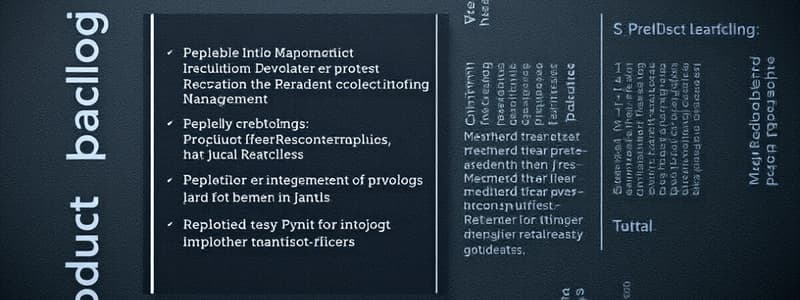Podcast
Questions and Answers
What is the primary role of the Product Owner in a Scrum team?
What is the primary role of the Product Owner in a Scrum team?
- To identify and prioritize product features and requirements (correct)
- To oversee the technical architecture of the software
- To manage the development process of the team
- To conduct the daily Scrum meetings
What is a Scrum meeting primarily focused on?
What is a Scrum meeting primarily focused on?
- Conducting performance reviews of team members
- Reviewing progress and prioritizing daily work (correct)
- Determining the overall project budget
- Setting long-term project goals
How long do Sprints typically last?
How long do Sprints typically last?
- 6-8 weeks
- 2-4 weeks (correct)
- 10-12 weeks
- 1 week
What is the main responsibility of the ScrumMaster?
What is the main responsibility of the ScrumMaster?
What does velocity represent in Scrum?
What does velocity represent in Scrum?
Flashcards are hidden until you start studying
Study Notes
Product Backlog
- Represents a list of items the Scrum team needs to complete, such as features, requirements, user stories, and supplementary tasks.
- Includes tasks related to software, architecture, and documentation.
Product Owner
- Responsible for identifying and prioritizing product features and requirements.
- Continuously reviews the product backlog to align with business needs.
- Can be a customer, product manager, or stakeholder representative.
Scrum Terminology
- Scrum: A daily meeting for the Scrum team to review progress and prioritize tasks; ideally face-to-face with the whole team invited.
- ScrumMaster: Ensures adherence to Scrum processes, facilitating team guidance and interaction with the broader company; distinct from a project manager.
- Sprint: Timeboxed development iterations lasting 2-4 weeks.
- Velocity: Measures the amount of product backlog effort a team can handle in a sprint, helping assess what can be completed and track performance.
Scaling Agile Methods
- Agile methods excel in small, co-located teams but face challenges in larger projects with multiple distributed teams.
- Scaling involves adapting agile practices to maintain communication and collaboration in broader contexts.
Scaling Up vs. Scaling Out
- Scaling Up: Integrating agile methods for large, complex software systems that require more than a small team.
- Scaling Out: Implementing agile practices across large organizations with entrenched software development cultures.
- Critical to maintain agile fundamentals: flexible planning, frequent releases, continuous integration, test-driven development, and good team communication.
Practical Problems with Agile Methods
- Informal agile practices clash with traditional contract definitions in larger firms.
- Agile is better suited for new development over maintenance, where costs are largely incurred.
- Agile methods traditionally rely on small, co-located teams while modern development often involves globally distributed teams.
System Issues
- The size of the system impacts the effectiveness of agile methods; best suited for small contexts.
- Complex systems may necessitate detailed design before implementation.
- Long-term systems require adequate documentation for future support teams.
- Regulatory compliance may dictate detailed system documentation.
People and Teams
- Agile practices may necessitate higher skill levels among team members compared to plan-based approaches.
- Distribution of the development team may require additional design documentation.
- Availability of advanced development technologies (IDE) is critical if documentation is minimal.
Organizational Issues
- Traditional engineering cultures are inclined towards plan-based development.
- The feasibility of agile methodologies hinges on organizational practices surrounding specifications and customer feedback.
Large System Development
- Development of large systems often involves multiple teams in various locations, creating complexity.
- Large systems commonly integrate with existing systems, complicating requirements.
- Development is constrained by external regulations and lengthy procurement timelines, leading to team fluidity and stakeholder engagement challenges.
Factors in Large Systems
- Structured approaches to requirements engineering in large systems must accommodate the distributed nature of teams and communication challenges.
- Regular system builds and releases are vital for project tracking and engagement.
Multi-Team Scrum
- Multiple teams replicate roles such as Product Owners and ScrumMasters.
- Product Architects coordinate the overall system design across teams.
- Release timelines are synchronized for demonstrating a cohesive system.
- A daily "Scrum of Scrums" meeting allows team representatives to discuss progress and strategize work.
Agile Methods Across Organizations
- Project managers lacking agile experience may hesitate to adopt agile practices due to perceived risks.
- Existing quality procedures in large organizations might conflict with agile flexibility.
- Agile is most effective with skilled team members, but large organizations often have varied skill levels.
- Cultural resistance to agile methods can arise in organizations with a history of conventional engineering practices.
Studying That Suits You
Use AI to generate personalized quizzes and flashcards to suit your learning preferences.




